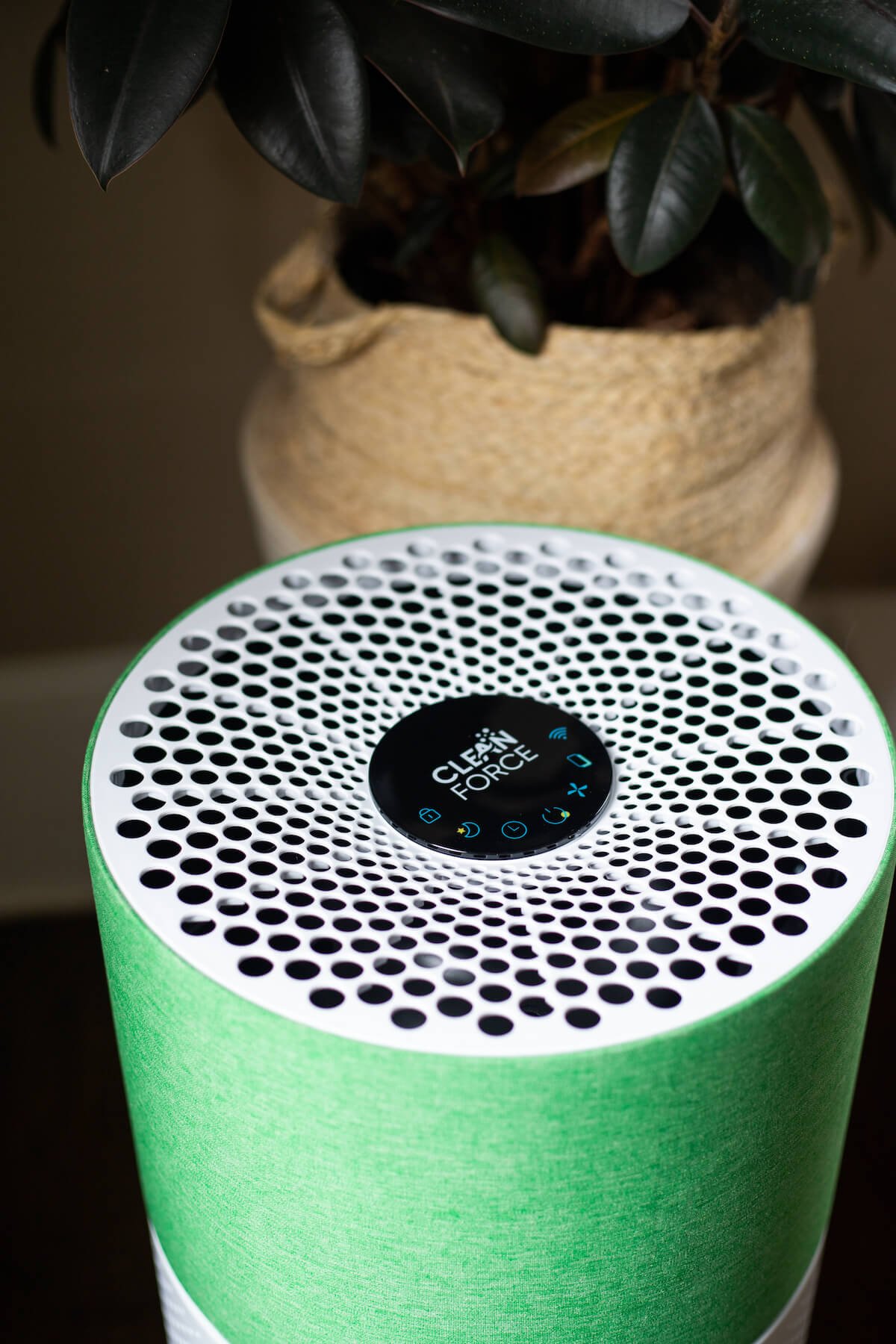11 Reasons Why An Air Purifier Should Be In Your Home
This post is sponsored by CleanForce, but all opinions are entirely our own. This post contains affiliate links. We earn a small commission for all purchases made through these links. Click here for the disclosure statement.
Chances are, you’re likely one of millions of Americans who are affected daily by air quality, whether that is a result of air pollution or simply a plethora of seasonal allergies. As our knowledge of the planet and environment increases, we are becoming more aware of just how important breathing quality air can be–not just to avoid allergies, but to reduce asthma attacks, the transmission of infectious diseases, and other health issues.
If you’ve been scouring the internet looking for ways to increase the indoor air quality in your home, you will have certainly come across a wide variety of air purifiers. These indoor air cleaners can range from under $20 for small, portable units with minimal features to expensive monstrosities that are loaded with features that you might never use (or need, for that matter).
So, where do you begin your search?
How Does An Air Purifier Work?
The overall mechanics of an air purifier are simple, although there may be many different varieties on the market, all with different systems.
An air purifier uses a fan to pull air in and then pushes it through a filter (or layer of filters) to remove dust, allergens, odors, and fine disease-causing particles. Once pushed through these filters, the clean air is then blown back into the room.
What Are The Different Types of Air Purifiers?
While it is true that no two air purifiers are the same, most use a variety of filters and technologies to clean the air in your home. Like many home items, there is a wide array of options to choose from, and it’s most important that you select one that has the features that you want for yourself, your family, and your home, while also staying within your budget.
Most larger air purifiers will utilize more than one of these filters to provide a higher quality of air return.
Cloth/Fabric Filters
Often called a ‘pre-filter,’ these thin outer layers help to pull out the largest particles (such as dust, pet hair, or pollen) from the air before being filtered into a stronger filter inside the air purifier.
HEPA Filters
When it comes to air purifiers, HEPA filters are the most common and therefore, the most familiar to many people. HEPA, or High-Efficiency Particulate Air, filters are very fine mesh filters that can pull small particles out of the air. However, not all HEPA filters are created equal. While each must meet the required standard, medical-grade HEPA filters have a finer mesh that is more effective at purifying the air.
Activated Carbon Filters
While HEPA filters are utilized to combat particles in the air, they do not remove or absorb odors, chemicals, or smoke. Activated carbon filters work by using a highly absorbent and porous material to lock on to these gases and prevent them from being recirculated into the air. For this reason, activated carbon filters are most often paired with other filters as part of an effective, multi-layered system.
Ultraviolet (UV) Light Filters
UV filters work best when paired with a mechanical filter–such as HEPA filters or activated carbon–because they do not remove particles from the air. However, for those looking to prevent airborne illnesses from striking, UV light can be effective in killing viruses and other germs in the air. A high-quality UV filter can destroy DNA and RNA pathogens effectively by blocking their reproduction.
Benefits of Using An Air Purifier
No matter which style or brand of air purifier that you choose, adding one into your home will come with a range of benefits.
Cleaner Air
The first reason might also be the most obvious, but bringing an air purifier into your home is a guaranteed way to increase the indoor air quality and keep outside air pollution and contaminants at bay. Even in the cleanest of homes, there will be lingering dust, pollen, mold, or other indoor allergens that lurk in forgotten corners and hide beneath large furniture. In fact, did you know that pollutants in your home’s air could be up to five times worse than outdoors? If that isn’t a reason to bring an air purifier into your home, we don’t know what is!
Eliminates Harmful Chemicals from Indoor Environments
While it might seem counterintuitive, many common household cleaning products–yes, even those meant to disinfect and sanitize–can reduce the quality of air in your home by producing volatile organic compounds (known as VOCs). These gases most often come from aerosol spray cleaners, but can also be found in glues and adhesives, and can cause harmful health issues with repeated exposure. Even though we might like the “clean” smell that comes from heavily fragranced cleaners (zesty lemon, anyone?), the cleanest air has no scent at all.
Removes Smoke
If you live in the drier parts of the United States, you are probably all too familiar with the yearly wildfire season and the importance of a high-quality air purifier for smoke. But, smoke pollution can come from other sources, too, such as cigarettes, cooking, and fireplaces. These smoky smells don’t just linger and damage your clothing and furniture–they can harm sensitive lungs, too.
Removes Odor
No one likes a smelly home! And, while we told you to avoid using heavily scented products filled with VOCs, it doesn’t mean that you have to put up with disgusting odors in your home. Whether an odor comes from a pet accident or a pile of long forgotten dirty laundry, a quality air purifier can pull even the finest particles (as small as 0.1 microns!) out of the air and trap them in an activated carbon filter.
Removes Common Allergens
Pet dander. Mold. Dust mites. Pollen. Hay fever. Seasonal allergies. No matter what you call them, your body’s overactive response to something in the environment is nothing to sneeze at (pun intended). If you are one of the over 50 million Americans that are affected by allergies, you know just how inconvenient sick days can be. A home air purifier with a HEPA filter can be an effective way to rid the indoor air of 99.97% of fine particles that cause most allergic reactions.
In fact, it’s been studied that an air purifier, when used for six weeks, can dramatically decrease the need for allergy medications. Who doesn’t love feeling great and saving money at the same time?
Asthma Attacks
Even if you don’t suffer from allergies, asthma can be exacerbated by poor air quality both outside and inside your home. Large and small particles in your home’s environment–mold, pet dander, and even smoke–can cause the airways of the lungs to swell, resulting in asthma attacks. While there is no cure for asthma, reducing these particles can be a pathway to reducing the frequency of these attacks or the symptoms.
Airborne Diseases
While no air purification system on its own can fully eliminate the airborne particles that can cause infectious disease, using an air cleaner in your home can be an effective way to reduce the chances of contracting an illness. The Environmental Protection Agency (EPA) has published its statement: an air purifier that is both the right size for your home and has a HEPA filter capable of capturing tiny particles (0.1-1 um) can be an effective way to remove viruses from the air.
Tip: Looking for a manufacturer that lists a high Clean Air Delivery Rate (CADR) for smoke is the best way to ensure that you are filtering out these tiny particles and breathing cleaner air.
Cleaning (Less Dust)
While air purifiers are largely heralded for their ability to mitigate health issues, one very simple benefit is a reduction in cleaning time. Yes, that’s right. If your air purifier pulls these particles out of the air, dust is less likely to accumulate on those hard-to-reach surfaces (ahem, ceiling fans). For us, cutting down on cleaning time is a win-win.
Works as White Noise
If you use sleep sound machines or white noise to fall asleep, you know that the gentle, consistent sound helps to block out external noise, especially if you live in a busy or high traffic area. However, an air purifier in your bedroom might be just another reason to trade in that old box fan.
White noise is considered a broadband sound, simply meaning that it contains an equal measure of each of the different frequencies of sound. The result is a sound that, to most people, often sounds like radio static, but is also effective in filtering out bothersome noise. The gentle fan of an air purifier can not only clean the air in the room, but provide much needed white noise to help you have a more restful sleep.
Better sleep
As mentioned before, a more peaceful night is going to result in better overall sleep. The white noise generated from an air purifier can help you fall asleep faster, while the filtration systems strip the air of particles and allergens that can trigger snoring or breathing troubles from allergens.
Better Cognitive Function
Have you ever woken up from a poor night’s sleep feeling restless, groggy, and foggy? Has that feeling impacted your ability to work the next day? This mental impairment can have a negative effect not only on your performance and decision-making skills, but on your ability to function during the day. We already know that sleep plays a large role in how well our brains function, but this can go beyond just time spent in bed. Research studies have been done showing that offices and workplaces that have cleaner air actually increase the concentration and productivity of their employees. With more people working from home than ever before, it’s even more important to breathe clean air at home!
Our Picks:
Image: Clean Force
Sleek & Portable
Rainbow Series Air
Clean Force
While some air cleaners can sacrifice power for portability, this sleek, colorful air purifier is perfect for those who want the best of both.
Why We Love It: Discover the ultimate air purifier that combines style and performance – the Rainbow Air Purifier! Its sleek, modern design comes in 5 eye-catching colors, perfect for adding a touch of vibrancy to any room. With a 550 CADR rating, it purifies large spaces up to 2550 sqft per hour. The Rainbow Series’ H13 True HEPA filter traps 99.97% of viruses, bacteria, and allergens, while an iMACT Active Carbon Filter removes wildfire smoke, cooking odors, or other harmful chemicals from the air. For tech lovers, it has a real-time pollutant detector, a responsive touchscreen, and hands-free capabilities with both voice commands (Hey Alexa!) and a smart app. Embrace clean, healthy air without compromising style – upgrade your home with the Rainbow Air Purifier today!
Image: Clean Force
Energy Efficient Power
Mega 1000 Air Purifier
Clean Force
Need extensive purification in an extra-large space? This is the option for you!
Why We Love It: The Mega 1000 has the highest CADR value on the market and can clean up to 4650 square feet in just 60 minutes, removing 99.97% of ultra-fine particles (like DNA/RNA viruses and bacteria!),While effectively neutralizing odors and harmful chemicals. Even better, it’s ENERGY STAR rated–meaning that it uses less energy than traditional, comparable purifiers–and has a smart sensor to automatically adjust the fan speed with real-time air quality readings. A great gift idea for new homeowners!
So, Are Air Purifiers Worth It?
We have to resoundingly say, yes! While the best air purifier for you needs to fit within your unique budget, it can save you money in the long run by protecting you from potential future health-related expenses. But, most importantly, having quality air in your home is a safe, effective way to protect not only yourself, but also everyone (pets included!) that lives in your home. That alone is something that you can’t put a price on.
#cleanforceair #cleanforce #airpurifier








